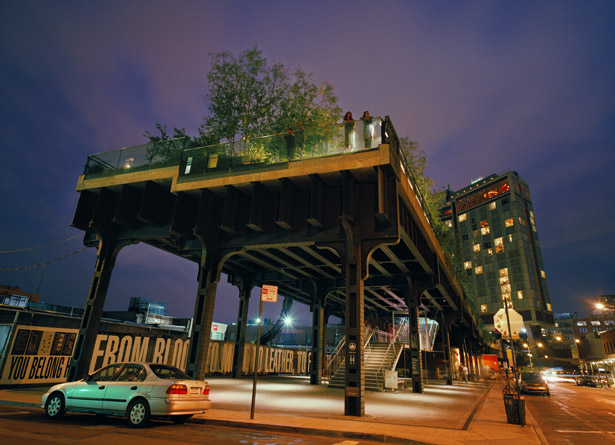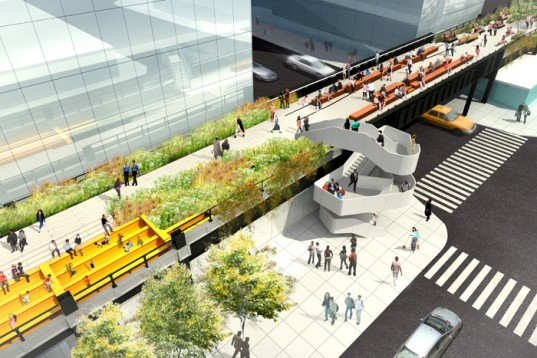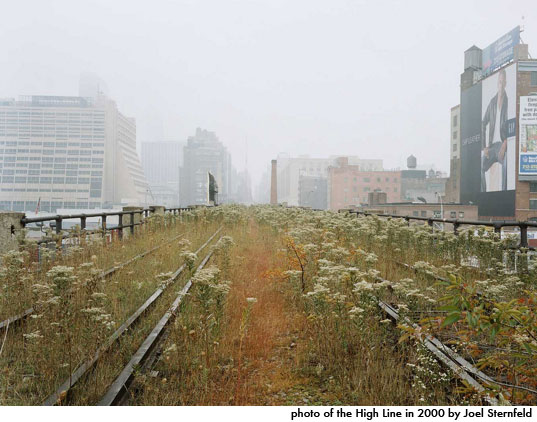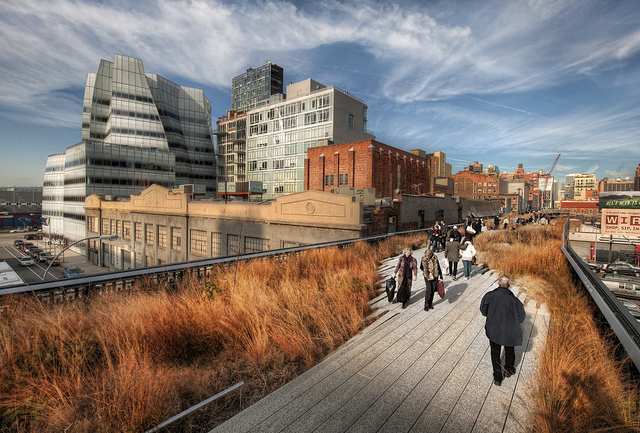Miracle Above Manhattan
New Yorkers can float over busy streets in an innovative park.
By Paul Goldberger
Photograph by Diane Cook and Len Jenshel
Parks in large cities are usually thought of as refuges, as islands of green amid seas of concrete and steel. When you approach the High Line in the Chelsea neighborhood on the lower west side of Manhattan, what you see first is the kind of thing urban parks were created to get away from—a harsh, heavy, black steel structure supporting an elevated rail line that once brought freight cars right into factories and warehouses and that looks, at least from a distance, more like an abandoned relic than an urban oasis.
Until recently the High Line was, in fact, an urban relic, and a crumbling one at that. Many of its neighbors, as well as New York’s mayor for much of the 1990s, Rudolph Giuliani, couldn’t wait to tear it down. His administration, aware that Chelsea was gentrifying into a neighborhood of galleries, restaurants, and loft living, felt the surviving portion of the High Line, which winds its way roughly a mile and a half from Gansevoort Street to 34th Street (a section farther south was torn down years ago), was an ugly deadweight. They were certain this remnant of a different kind of city had to be removed for the neighborhood to realize its full potential.
Never have public officials been so wrong. Almost a decade after the Giuliani administration tried to tear the High Line down, it has been turned into one of the most innovative and inviting public spaces in New York City and perhaps the entire country. The black steel columns that once supported abandoned train tracks now hold up an elevated park—part promenade, part town square, part botanical garden. The southern third, which begins at Gansevoort Street and extends to West 20th Street, crossing Tenth Avenue along the way, opened in the summer of 2009. This spring a second section will open, extending the park ten more blocks, roughly a half mile, to 30th Street. Eventually, supporters hope, the park will cover the rest of the High Line.
Walking on the High Line is unlike any other experience in New York. You float about 25 feet above the ground, at once connected to street life and far away from it. You can sit surrounded by carefully tended plantings and take in the sun and the Hudson River views, or you can walk the line as it slices between old buildings and past striking new ones. I have walked the High Line dozens of times, and its vantage point, different from that of any street, sidewalk, or park, never ceases to surprise and delight. Not the least of the remarkable things about the High Line is the way, without streets to cross or traffic lights to wait for, ten blocks pass as quickly as two.
New York is a city in which good things rarely happen easily and where good designs are often compromised, if they are built at all. The High Line is a happy exception, that rare New York situation in which a wonderful idea was not only realized but turned out better than anyone had imagined. It isn’t often in any city, let alone New York, that an unusually sophisticated concept for a public place makes its way through the design process, the political process, and the construction process largely intact. The designers were landscape architect James Corner of Field Operations and the architecture firm of Diller Scofidio + Renfro, who joined forces to produce the winning scheme in a competition that pitted them against such notables as Zaha Hadid, Steven Holl, and landscape architect Michael Van Valkenburgh.
Their plan struck a balance between refinement and the rough-hewn, industrial quality of the High Line. “We envisioned it as one long, meandering ribbon but with special episodes,” Corner told me. “We wanted to keep the feeling of the High Line consistent but at the same time have some variations.” The design included sleek wooden benches that appear to peel up from the park surface, but also kept many of the original train tracks, setting them into portions of the pavement and landscape. Working with Dutch landscape architect Piet Oudolf, Corner recommended a wide range of plantings, with heavy leanings toward tall grasses and reeds that recalled the wildflowers and weeds that had sprung up during the High Line’s long abandonment. (The line, which opened in 1934, was little used after the 1960s, although its final train, carrying frozen turkeys, didn’t travel down the track until 1980.)
Early in the two and a half decades that the High Line was unused and untouched, an obsessive rail buff named Peter Obletz purchased the elevated structure for ten dollars from Conrail with the intention of restoring it to rail use. Obletz’s ownership was held up in a five-year legal battle, which he lost. He died in 1996 but is, in a sense, a spiritual parent of the High Line preservation effort. So is photographer Joel Sternfeld. During the derelict years he made striking images of the High Line as a ribbon of green snaking through an industrial cityscape. Widely reproduced, his photographs played a significant role in building a constituency for saving the line for public use. Sternfeld showed that this clunky industrial object really could look like a park.




